It’s not often that you hear good news from Zimbabwe, and even rarer that you hear good news in conservation. So this blog might come as a surprise to some because for once it’s not bad news! If you came along to the fundraiser I did with the SAVE Foundation in Sydney in August last year, linked to the launch of my latest book “Planet Elephant“, you helped raise funds for the intensive anti-poaching efforts being led by specialists Bryce and Lara Clemence of Aggressive Tracking Specialists (ATS) in the Save Valley Conservancy, Zimbabwe.
Recently I asked Bryce a few questions about how things are going on the ground for the conservancy’s rhinos, and I think it’s fair to say the funds you helped raise for them are making a difference. For me the graph below says a lot – since the ATS team started in 2012, they’ve lost less rhinos to poachers in the area, and there’s more encouraging news here from Bryce too. The fight is far from over for Zimbabwe’s rhinos, but we need to celebrate and continue to support on ground efforts that are making a difference like this if they are to survive. This video below is a re-enactment of a heart-rending story about a mother rhino’s love (and some of the cutest baby rhino footage you’ll ever see).
When did you and Lara start your anti-poaching in SVC and what progress have you made so far?
ATS started on the 11th of April 2012 with a 2-month appraisal of the anti-poaching situation in Save Valley Conservancy. During this appraisal we found a number of aspects that needed urgent changing. Probably the most important aspect that needed to change was that the previous unit was almost entirely reactive and not proactive. We signed a contract with SVC in June 2012 and have been here since. We started from scratch and established the Special Species Protection Unit (SSPU), which we have founded on a very proactive strategy. To date we have had a number of very crucial successes that have been key in bringing back a positive rhino growth rate. To date we have captured 10 rhino poachers and recovered 4 weapons used for rhino poaching, of which 3 of these were automatic assault rifles.
I heard that a baby was saved last year after its mother was poached. Can you tell us this story and let us know what has happened to him now?
Yes this was very sad indeed! It was a newborn baby, approximately 5 days old. The mother was busy moving the calf to a new location trying to evade predators when she was intercepted and killed by a hardcore poaching group. It was a miracle that the calf survived after spending a whole night alone. Take a look at the reenactment that we did on this story (video above). The good news is that the baby rhino is doing well and we were able to turn this into a positive by raising a lot of awareness and funding to continue to support the cause.
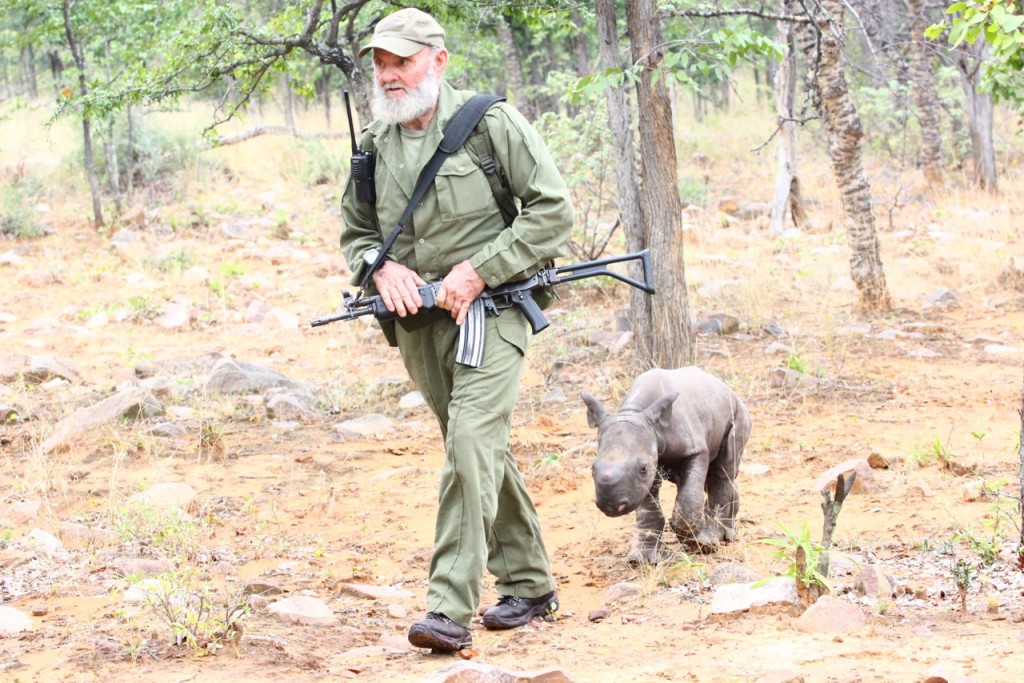
Bryce’s father, Pete Clemence, with a baby rhino saved after its mother was poached last year in Save Valley Conservancy, Zimbabwe. The calf is now being rehabilitated at a nearby conservancy for eventual return to the wild.
How many rhinos have been lost in SVC in 2012, 2013 and this year so far to poachers? 2012-16, 2013-3, 2014- 5.
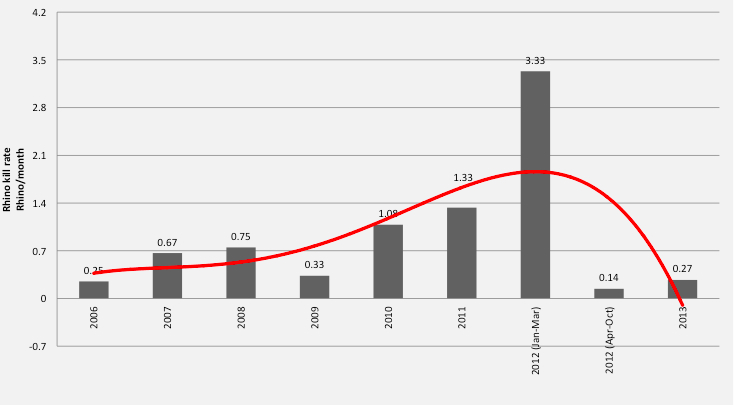
Graph showing rhino poaching over time. 2012 was the year that ATS began intensive rhino anti-poaching in the Save Valley Conservancy. (copyright ATS)
You have caught a number of poachers in the past year. Tell us what happened once they were transferred to the courts. Were they prosecuted and if so, what sentence did they get?
The judicial system in our country is very weak with regard to the prosecution of wildlife crime. I think this largely ties into the political situation. Efforts are being made by a number of NGO’s to raise awareness and increase accountability within the judiciary. Success boils down to “who you know” more so than “what you know”.
Do you think the sentences provide enough disincentive to keep other poachers away from the rhinos?
In most cases no, definitely not, however as mentioned above a lot of effort is being made to improve in this area and we are already starting to reap the reward. A point of note though is that to date none of those who were actually captured or wounded here have returned to poach rhino within SVC. As a matter of fact, some of them have left the country.
Recently a baby rhino was killed, 9 months old – tell us why poachers kill baby rhinos that have hardly any horn.
This is because rhino horn is worth more in weight than raw gold & so any amount of rhino horn is taken & often in the most ruthless manner. Rhino poachers are motivated by pure greed & have no sympathy whatsoever. This is why we disagree with the de-horning of rhino. There are countless examples of de-horned rhino that have been poached because the piece of horn that is removed when de-horning is only a third of the weight of what is left behind on the animal.
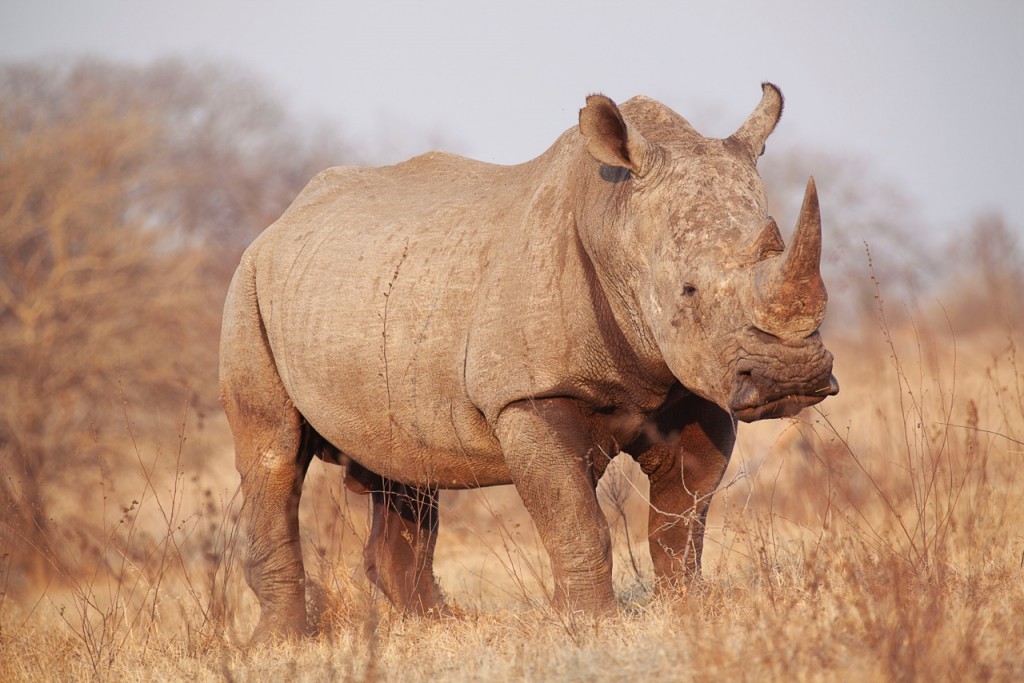
One of the rhinos in Save that ATS is working so hard to protect, this one a white rhino (copyright ATS)
Australians supported your program by coming to my book launches last year in Sydney and some of that money went to training new rangers. Can you tell us how the training is going and what impact it’s having?
The training has been absolutely crucial for the building up of the Special Species Protection Unit (SSPU). Manpower has been without doubt & still remains our biggest challenge. We are protecting an area of 3000 square kilometers, which is an enormous task! Although the greatest threat is to the rhino, we protect all wildlife & deal with all illegal activity whilst in the course of duty & so success is entirely dependent on the quality of the men that we select & the type of training that they receive. The support that we have received from you to date & from the Australian people has gone a very long way and been substantial in making this project a success. We are sincerely grateful! It is our firm belief that our people are our greatest asset and the key to present and future success. The recruitment and training of our rangers has provided employment to the surrounding areas, which in turn increases community co-operation and support.
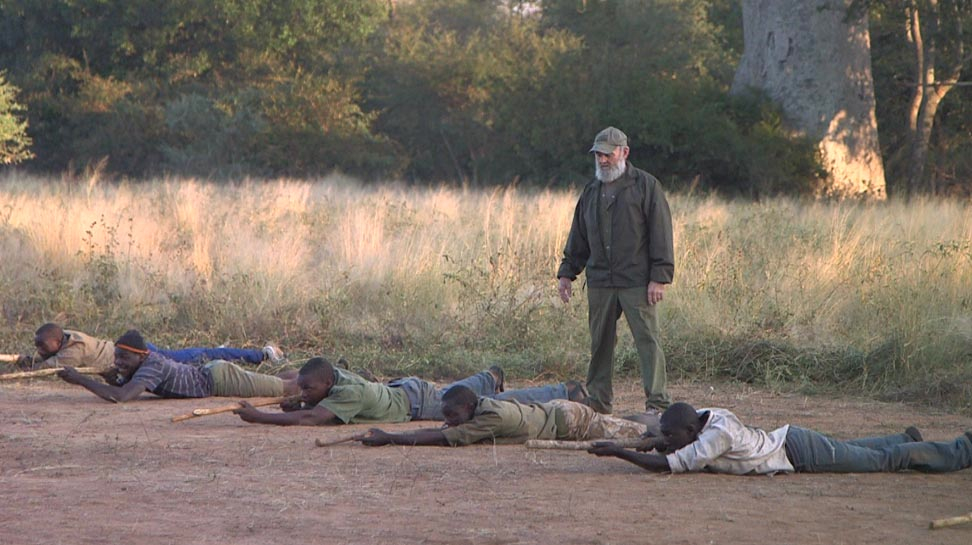
Bryce’s father, Pete, pictured above with trainee rangers, is a key trainer in ATS’s anti-poaching rangers program. Training more local people to be an on-ground deterrent to poachers is essential in this battle.
What keeps you going when things get tough?
The fact that the Rhino are doomed without good men on the ground is a very strong factor that keeps us going through the hard times. Also the level of cruelty that we’ve witnessed in some of the rhino related crime scenes drives us to want to bring the perpetrators to justice. We realize that the rhino are entirely dependent on our efforts in the field.
When people donate to the SAVE Foundation, they are helping keep you going. Can you tell us what this means to you and why it’s so essential in the battle to save Zimbabwe’s rhinos?
It means so much to us! This is also a factor that helps keep us going through the hard times, just knowing that other people care is very encouraging to us and their support is a constant reminder to us that they do actually care and we are not alone on the front lines. This is massive for our morale!
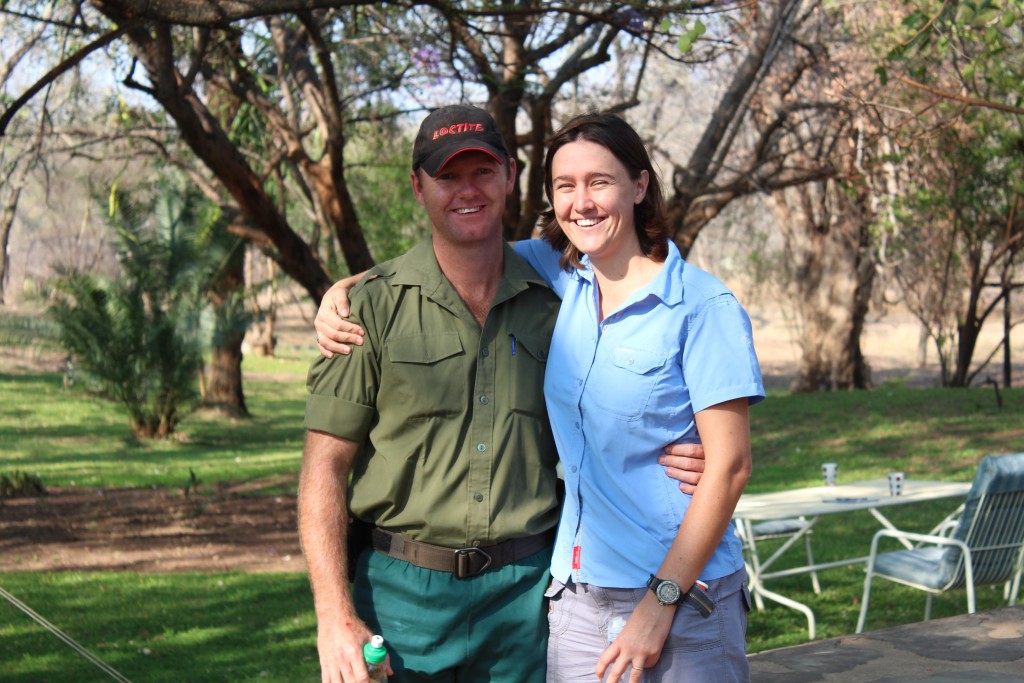
Bryce and Lara Clemence, the young couple who head up Aggressive Tracking Specialists, Save Valley Conservancy, Zimbabwe, on the front line of Africa’s war on rhino poachers
You can donate to ATS’s anti-poaching efforts in Zimbabwe through the SAVE Foundation (for tax deductible Australian donations) or directly to the Save Valley Conservancy. Let’s help keep these guys going! And if you’d like to see how these guys operate in action, I’ll be including time with the anti-poaching team as part of a personally-led safari to Zimbabwe in mid-2016 – so watch this space!

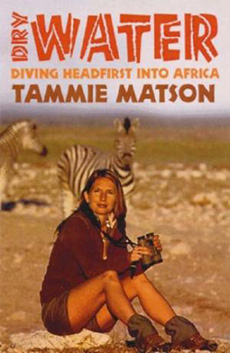

That’s a remarkable achievement in a few years,well done ATS.I admire the efforts and as a Zimbawean youths I appreciate your efforts.
Hi Dave, many of the guys on the ground in Africa tell me they can’t fight this battle alone. My view is we really need a multi pronged attack on illegal ivory trade – targeting not only the poachers as Bryce and team are doing but the whole trade chain, the criminal gangs involved, the buyers in Asia and elsewhere (and I agree, it’s not only China of course, people buy ivory all over the world).
Much of the ivory and rhino horn is used by terror groups for funding, so blaming the Chinese may be a little misplaced. You would be surprised how much ivory ends up in the 1st world, purchased by high end clientiel.
I agree with Bryce, more trained feet on the ground is a better deterrent.
Hi Dinah – I couldn’t agree with you more. The source of Africa’s poaching scourge is really the demand for elephant and rhino ivory and horn respectively. That’s why I started the Let Elephants Be Elephants campaign with Asian TV star Nadya Hutagalung – take a look at http://www.letelephantsbeelephants.org and take the pledge there to say no to ivory. We really need to stop the demand as that is the source of this issue, and capacity and resources to fight poaching endlessly in Africa is just not a sustainable solution. In a week or so I’ll be putting out a blog with an interview in it with Lynn Johnson who runs the Breaking The Brand campaign – a good example of fighting demand for rhino horn at the source, in Vietnam. http://www.breakingthebrand.org
Hello Tammie,
Thank you for posting this story – being a person who lived in Kariba for 10 years, I know the Clemence family very well and have huge admiration for what they are doing on their own like this.
I see all these various sites “Save The Rhino” and they are heart-warming to say the least – but the question begs – why is all the effort going into Saving the Rhino instead of an International outcry and effort to take the Chinese and other Eastern cultures to task over this.
Why is the cause not being dealt with instead of the symptoms?
Why are we not banning all importation of horn and tusks into the Eastern countries at an International level?
It’s all very well berating and shooting the poachers but we need to ask who and what are they and what is motivating them? The answer is simple; money of course to the desperate who need it and employed and paid pittance by a corrupt and greedy government in huge debt to the Chinese.
This is where the problem is.
Every time I come across those terrible photos of the butchered Rhino, I inbox them to every Chinese group I can find on Facebook.
Here’s one man trying to save the Elephants – maybe he can also make a point regarding our Rhino.
http://www.washingtonpost.com/world/ex-rocket-yao-ming-aims-to-save-africas-elephants–with-china-campaign/2014/09/03/87ebbe2a-d3e1-4283-964e-8d87dea397d6_story.html
But bless you Dr Tammie for your lovely article.
My warmest regards
Dinah
That’s fantastic Lynn – good on you for supporting them. I’ll be personally taking a small group to see their work next year (2016) mid year for a very special behind the scenes experience.
Through a trip I did to Sango last year with the Save Foundation – I first hand witnessed the amazing effort Bryce, Lara, Dave, Pete and everyone there is doing to help save these beautiful animals.
This year 2015 I am returning with the Save Foundation to help support this effort by donating to the Ranger Support Scheme.
Thanks for posting this story on the situation in the SVC and the effort of the Clemence family. These people and the men they employ should be given far more attention than they do so thanks for playing your part in highlighting their efforts. The story of the orphaned rhino was sad but also hopeful.
your time and dedication to the cause of saving the Rhino is commendable, we wish you every sucess and pray for your safety and the safety of the animals so cruelly poached. When will man realise the the destruction of Gods beautiful creation can not continue.